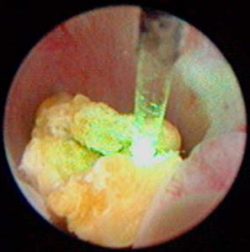ENDOSCOPY
Used to identify anatomic anomalies, obtain biopsy and culture specimens, and identify and remove foreign material.
- laryngoscopy and tracheoscopy (larynx and trachea or windpipe)
- bronchoscopy (airways and lungs)
- cystoscopy (bladder and urethra)
- endourology (urethra, bladder, vagina, preputial cavity)
- colonoscopy (large intestine)
- esophagoscopy (esophagus)
- gastroduodenoscopy (stomach and upper small intestines)
- rhinoscopy (nasal cavity)
- laparoscopy (minimally invasive surgery for biopsies of internal organs)

LASER LITHOTRIPSY
A laser beam is used to fragment bladder stones into pieces that are small enough for the animal to pass or to be removed with a snare, thereby avoiding surgery, as seen at right.

LASER ABLATION
Ectopic ureters are a cause of urinary incontinence in young dogs.
Urine travels from the kidneys to the bladder in two thin tubes called ureters. An ectopic ureter is one that opens into any place other than the normal position in the bladder. The photo on the right shows an orange catheter in an ectopic ureter.
The laser is used to ablate (cut the surface of) one side of the ureter so that the new opening will be inside the bladder.
RADIOIODINE 131I FOR HYPERTHYROIDISM IN CATS
Radioactive iodine is most often used to treat hyperthyroidism in cats. The most common cause of feline hyperthyroidism is benign adenomatous change.
